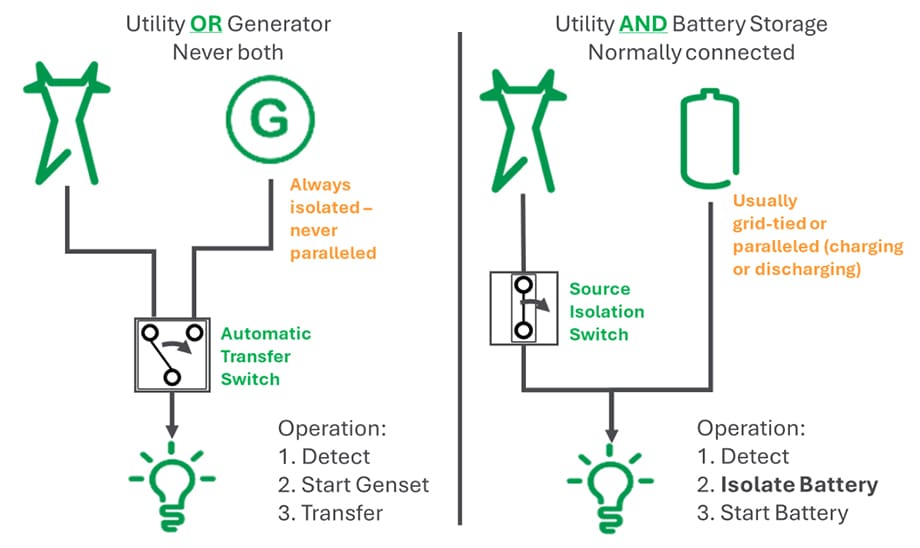As Battery Energy Storage Systems (BESSs) emerge as important tools in the evolving energy landscape, maximizing their benefits is crucial to assuring maximum return on investment. Like microgrids, an inverter-controlled BESS provides flexibility to consume or store energy when utility rates are lowest and use this stored power when rates increase, a practice known as energy arbitrage. A BESS can also be used as a backup power supply to improve resilience when utility power outages occur.
Engineers face a learning curve when deploying inverter-controlled power sources such as a BESS. While solar panels and BESSs can run in parallel with a utility feed to optimize energy costs, their inverters must shut down when a utility outage occurs. To power essential loads during a utility outage, a means of isolating an inverter-controlled power source from a utility source is required. Once isolated, an inverter can safely return to operation to power its essential loads. A basic form of microgrid controller can supervise these functions.
Because they are familiar with backup power applications, engineers may be inclined to design an isolation means using automatic transfer switches (ATS). A better solution for these isolation needs is a source isolation switch (SIS) that enhances both safety and on-site power resilience by disconnecting an inverter-controlled power source from a utility feed.
Drawbacks of using ATS for isolation
The intended purpose of an ATS is not to isolate a power source. Rather, an ATS detects when a grid outage occurs and signals a genset to start and then accept a load transfer. Consequently, ATS manufacturers design their products to connect to power continually, and ATS controllers use operating sequences that are inappropriate for isolation. As a result, engineers must assemble multiple devices to improvise a functional isolation solution. Those components include controllers, breakers, and metering devices to monitor the incoming power.
To deploy such systems, each component must be installed, connected, and tested to commission the backup power system. Although the transfer switches may be UL-listed, the standard to which they are listed may not have been created for devices that isolate a power source. UL 1008 Standard for Safety to which many transfer switches are listed addresses transferring loads between power sources, not source isolation. Using a listed switch to isolate a utility source is beyond the scope of UL 1008. Such switches also may not have been tested in the equipment combinations needed to achieve the type of isolation required by codes. Consequently, this approach adds cost, complexity, and uncertainty to the deployment process and can increase malfunction risk by adding potential failure points.
Simple solution – a source isolation switch
A simpler approach is to deploy an SIS. The one-line diagram below shows conceptual differences between an ATS and an SIS.

An SIS is a more sensible and cost-effective isolation solution for multiple reasons:
- Standardization – The new UL 3008 guidance addresses how interconnect isolation devices can safely work with inverters. The new standard is based on UL 1008, which defines how transfer switches can safely work with generators. UL 3008 is the first standard to specify requirements for devices that isolate on-site inverters from utility feeds. The 600-amp ASCO SourcePacT™ is the first SIS specifically designed to comply with UL 3008. SourcePacT can streamline the deployment of inverter-controlled systems in places like California, which has already mandated solar panels and BESS at commercial building sites.
- Integration – Since an SIS integrates all the necessary isolation components into one device (including an integrated controller), engineers can easily specify an appropriate isolation solution. Specifying a UL 3008 SIS like SourcePacT reduces engineering time and deployment costs. This pre-configured and pretested solution streamlines procurement because SourcePacT can be easily obtained from distributors.
- Installation —Electrical contractors also benefit from deploying SourcePacT. It streamlines their work because they install, test, and commission far fewer components. In addition, users must no longer deal with three or four devices with separate controls from multiple manufacturers to achieve proper isolation. This simplifies training and maintenance and reduces the risk of human error.
- Cost—Wherever organizations encounter utility reliability issues, they often install solar panels and a genset with the help of government subsidies. Deploying SIS devices like SourcePacT enables the use of smaller generators, reducing capital costs, operating costs, and carbon emissions.
To learn more about power source management and using a BESS for backup power, download the new ASCO white paper SourcePacT Source Isolation Switch Basics. For further information, visit the SourcePacT webpage, email ASCO Customer Care, or contact a local ASCO representative.




Add a comment